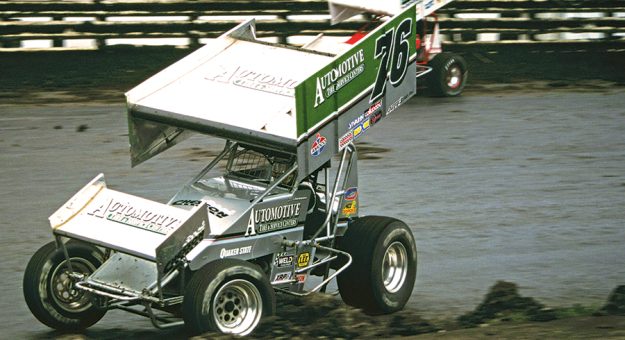With his modified team, Pete had spent years operating as a local racer. Eager for the next level, the siren of the road was calling.
“We only raced Williams Grove maybe like a couple times,” P.J. shareed, “and Dad goes, ‘You guys wanna go race with the World of Outlaws?‘”
And, just like that, the Chessons began towing to tracks across the country to compete against Ted Johnson‘s lineup of the best sprint car racers in the world.
Both brothers share that they more than held their own qualifying against the Outlaws regulars, timing well most nights, but needed to work hard to improve their skills competing in the heats and features. A P.J. bluntly put it, “We could go fast, but we couldn‘t race.”
A decision not to run for points in favor of a traditional “outlaw” schedule allowed the family to choose which venues they wished to compete at and which they could pass up in favor of running locally in Pennsylvania.
“Ted Johnson was real great with us,” P.J. recalls. “We got along great with Ted. He would take good care of us because we would bring two cars. We wouldn‘t just bring one car, we had two cars.”

Having never before seen most of the tracks on the Outlaws schedule, and not dependent on commitments to sponsors, there were times when the Chesson team would tow to an event, pull into the pits, and survey the facility before Pete would decide that if the lighting, fencing, or other factors didn‘t look safe, his boys weren‘t going to run that night.
That, P.J. admitted, did sometimes irk the Outlaws president.
“We would go there, watch the race, and we wouldn‘t even unload some of the time,” P.J. remembered. “And that was the luxury … our dad was super-cool, right? He was like, if it‘s not safe or the track isn‘t good, we won‘t even pull the cars out of the trailer. And Ted was just as cool. He was like, ‘Are you guys kidding me? You‘re gonna drive all the way here and you‘re not gonna pull them out of the trailer?‘
“If we just felt like it wasn‘t a safe place, we had the luxury of not having to go there, not having to race.”
Their sprint car careers continued to progress, and P.J. won at Williams Grove, winning a Friday night non-qualifier feature at the Knoxville Nationals in 2002, two World of Outlaws victories (at New Egypt and Fargo, both in 2002), and the highlight of his sprint car career: claiming Earl Baltes‘ unsanctioned $100,000-to-win Historical Big One in 2001.
In addition, he competed in New Zealand for Baypark Speedway promoter Willie Kay, earning three South Pacific sprint car titles, and continued to race sprints through 2003.
Meanwhile, by 2002, James had transitioned from winged sprint cars to USAC midgets and Silver Crown cars.
“Getting into the midgets and Silver Crown, and just pavement in general, was a bigger picture thinking for me, at the time,” James shared, “and the Outlaws were more of a stepping stone for me.”
That shift to pavement racing in hopes of developing an opportunity to run IndyCar or NASCAR included relocating to Indianapolis.
“I moved out there,” James explained. “Kasey (Kahne) and I were good buddies, and we were just kind of bumming around. And I was actually renting Jason Leffler‘s apartment in Indy for a while and then we had a shop on Gasoline Alley for doing all that stuff, which was good, you know, centrally located to get around to a lot of stuff. And that was part of my game plan.”

Like his brother, P.J. was also working to get to IndyCar or NASCAR. Although he enjoyed racing them, and still admits that nothing compares to the thrill of piloting a sprint car, being a sprint car racer on the road proved to be a grueling lifestyle.
“I think for me it was the monotony of being in the hotel room, in a parking lot, being in a car wash. Even though you‘re in different places, the life is very much like Groundhog Day.”
In 2004, both brothers headed to Indy Lights (then called the Infiniti Pro Series). James took a win at California Speedway in his second race with the series, with P.J. running second, and the fans were treated to both brothers simultaneously doing donuts on the frontstretch.
P.J. claimed three wins in a row — at Michigan, Kentucky, and Pikes Peak — that year with the series. The Chesson brothers proved that they were exciting for the fans and could win races in the rear-engine cars. However, their rides were drying up.
In the meantime, P.J. made an appearance on The Howard Stern Show, accompanying his then-girlfriend, Playboy Playmate Echo Johnson.
“They did that thing where, you know, let‘s meet the douchebag that‘s dating the hot chick,” he said with a hearty laugh. “So, I got to go on as the douchebag, but I ended up hitting it off pretty well with Howard and it was a good time. We ended up hanging out a little bit after the show even.”
When KISS bassist and marketing guru Gene Simmons was recruited by the IndyCar series to boost PR efforts, he voiced concern regarding the lack of American racers in the field. In particular, he wanted an American open-wheel racer that exuded personality.
With financial backing from NBA basketball star Carmelo Anthony, Ron Hemelgarn agreed to field a car for P.J. for the full 2006 season, including the 90th running of the Indy 500. The brash young sprint car racer seemed to be the exact spark the series needed.
However, a late start by the team resulted in a thrown-together effort, reflected by DNF‘s in early season events.
Click below to continue reading.
